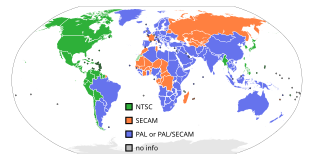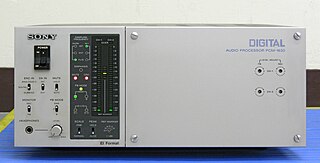
Analog television is the original television technology that uses analog signals to transmit video and audio. In an analog television broadcast, the brightness, colors and sound are represented by amplitude, phase and frequency of an analog signal.

NTSC is the first American standard for analog television, published and adopted in 1941. In 1961, it was assigned the designation System M. It is also known as EIA standard 170.

Phase Alternating Line (PAL) is a colour encoding system for analog television. It was one of three major analogue colour television standards, the others being NTSC and SECAM. In most countries it was broadcast at 625 lines, 50 fields per second, and associated with CCIR analogue broadcast television systems B, D, G, H, I or K. The articles on analog broadcast television systems further describe frame rates, image resolution, and audio modulation.

SECAM, also written SÉCAM, is an analog color television system that was used in France, Russia and some other countries or territories of Europe and Africa. It was one of three major analog color television standards, the others being PAL and NTSC. Like PAL, a SECAM picture is also made up of 625 interlaced lines and is displayed at a rate of 25 frames per second. However, due to the way SECAM processes color information, it is not compatible with the PAL video format standard. SECAM video is composite video; the luminance and chrominance are transmitted together as one signal.

The VHS is a standard for consumer-level analog video recording on tape cassettes, introduced in 1976 by the Victor Company of Japan (JVC). It was the dominant home video format throughout the tape media period in the late 1970s, 1980s, and 1990s.

Interlaced video is a technique for doubling the perceived frame rate of a video display without consuming extra bandwidth. The interlaced signal contains two fields of a video frame captured consecutively. This enhances motion perception to the viewer, and reduces flicker by taking advantage of the characteristics of the human visual system.

Composite video is an baseband analog video format that typically carries a 405, 525 or 625 line interlaced black and white or color signal, on a single channel, unlike the higher-quality S-Video and the even higher-quality YPbPr.

Telecine is the process of transferring film into video and is performed in a color suite. The term is also used to refer to the equipment used in this post-production process.

A test card, also known as a test pattern or start-up/closedown test, is a television test signal, typically broadcast at times when the transmitter is active but no program is being broadcast.
Broadcasttelevision systems are the encoding or formatting systems for the transmission and reception of terrestrial television signals.
Because the NTSC color television standard relies on the absolute phase of the color information, color errors occur when the phase of the video signal is altered between source and receiver, or due to non linearities in electronics. To correct for phase errors, a tint control is provided on NTSC television sets, which allows the user to manually adjust the phase relationship between the color information in the video and the reference for decoding the color information, known as the "color burst", so that correct colors may be displayed.

576i is a standard-definition digital video mode, originally used for digitizing 625 line analogue television in most countries of the world where the utility frequency for electric power distribution is 50 Hz. Because of its close association with the legacy colour encoding systems, it is often referred to as PAL, PAL/SECAM or SECAM when compared to its 60 Hz NTSC-colour-encoded counterpart, 480i.

DVD region codes are a digital rights management technique introduced in 1997. It is designed to allow rights holders to control the international distribution of a DVD release, including its content, release date, and price, all according to the appropriate region.

A PCM adaptor is a device that encodes digital audio as video for recording on a videocassette recorder. The adapter also has the ability to decode a video signal back to digital audio for playback. This digital audio system was used for mastering early compact discs.
The 405-line monochrome analogue television broadcasting system was the first fully electronic television system to be used in regular broadcasting. The number of television lines influences the image resolution, or quality of the picture.

PAL-M is the analogue colour TV system used in Brazil since early 1972, making it the first South American country to broadcast in colour.
Television standards conversion is the process of changing a television transmission or recording from one video system to another. Converting video between different numbers of lines, frame rates, and color models in video pictures is a complex technical problem. However, the international exchange of television programming makes standards conversion necessary so that video may be viewed in another nation with a differing standard. Typically video is fed into video standards converter which produces a copy according to a different video standard. One of the most common conversions is between the NTSC and PAL standards.
Broadcast-safe video is a term used in the broadcast industry to define video and audio compliant with the technical or regulatory broadcast requirements of the target area or region the feed might be broadcasting to. In the United States, the Federal Communications Commission (FCC) is the regulatory authority; in most of Europe, standards are set by the European Broadcasting Union (EBU).

CCIR System B was the 625-line VHF analog broadcast television system which at its peak was adopted by more than one hundred countries, either with PAL or SECAM colour. It is usually associated with CCIR System G for UHF broadcasts.

CCIR System I is an analogue broadcast television system. It was first used in the Republic of Ireland starting in December 1961 as the 625-line broadcasting standard to be used on VHF Band I and Band III, sharing Band III with 405-line System A signals radiated in the north and east of the country. The Republic of Ireland slowly extended its use of System I onto the UHF bands.










